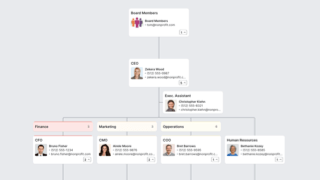Nonprofit Organizational Chart
Check out this nonprofit org chart we built in Pingboard. See how your team can quickly view your nonprofit’s structure, job titles, hierarchy, and staff contact info. This type of interactive org chart is great for increasing transparency and connecting your people.
Below the org chart, we’ve also included the most common nonprofit job titles and descriptions. Use this info to help you build out a well-rounded nonprofit organization.
Ready to get started?
Download the Nonprofit org chart template above, add your own employee data, and Import into Pingboard. Note: you’ll need a Pingboard account first. Sign up for a free trial.
Pro Tip You can build your org chart automatically. Instead of filling out a spreadsheet, you can connect your HR system to Pingboard to automatically sync employee data. Your org chart will get updated automatically every time a change happens. We integrate with ADP, Azure, BambooHR, Google Apps, Namely, Okta, and more.
Nonprofit Job Title Hierarchy + Most Common Roles
Board of Directors
Most established nonprofits have a board of directors that volunteer to determine the direction, goals, and strategies of the organization. The board of directors is responsible for ensuring the organization has all of the resources needed to be successful, like finances, staff, and strategic guidance. Here are some more specific tasks that members of the board are responsible for:
- Helping to determine the mission and vision of the nonprofit
- Hiring a CEO and setting expectations
- Establishing initial funding strategies and providing ongoing guidance around donations
- Serving as legal experts and setting ethical standards
- Coming together quarterly to assess the nonprofit’s performance and recommend strategies for improvement
Chief Executive Officer (CEO)
The CEO is the face of the organization and is expected to execute the goals and expectations determined by the board of directors. She is expected to manage the day to day operations of the organization, and it’s common for the CEO to sit on the board so they have a say in the general direction of the nonprofit. Here are a few more specific responsibilities found in the CEO’s job description:
- Partnering with other executives at the nonprofit to establish marketing, finance, and fundraising strategies
- Identifying new opportunities and avenues to support strategic growth
- Building and cultivating relationships with industry leaders and potential supporters
- Preparing reports for board meetings that provide transparency into the overall performance of fundraising, marketing, and operations
Chief Financial Officer (CFO)
The Chief Financial Officer works in partnership with the CEO and board on the development and administration of the nonprofit’s finance policies, accounting, insurance, payroll, and internal controls and auditing. The CFO is responsible for maintenance of records and procedures to adequately safeguard the assets of the nonprofit, and to provide leadership on long-range solutions for cost-effective support, encouraging excellence in the staff, and modeling behaviors and attitudes for a progressive financial function. Here are a few examples of responsibilities found in nonprofit CFO job descriptions:
- Interpreting and explaining financial statements and other financial issues to leadership and the board
- Overseeing cash flow management, and managing accounting, general ledger and operations functions, ensuring that systems are in place to guarantee timeliness and accuracy
- Consulting the CEO, Board, and other key stakeholders on all financial matters, making recommendations, and suggesting proactive strategies to keep the nonprofit ahead of its goals
- Generating monthly, quarterly, and annual reports as needed to monitor, evaluate, and optimize cash-flow and liquidity
Chief Marketing Officer (CMO)
The Chief Marketing Officer is responsible for the development of a strategic communications, public relations, and marketing plan for the nonprofit. This role also directly manages activities that promote, enhance, and protect the organization’s brand identity. This individual is an ambassador for the nonprofit and builds relationships with the media and public. Here are a few specific tasks anonprofit CMO is responsible for:
- Implementing a comprehensive marketing and communications plan designed to increase understanding and awareness of the nonprofit among target audiences, including media, donors, business partners, elected officials, colleagues in the field, and civic and community leaders
- Providing leadership, supervision, and mentorship for the professional growth and success of the marketing team
- Working on brand management, including building a team to coordinate, execute and monitor the design and production of marketing and communication tools (website, social media, monthly e-newsletter, video, annual reports, direct emails, online giving support, brochures, and other materials)
- Collaborating with the executive team to align marketing and communication strategies to support fundraising plans
Director of Development/Fundraising
The Director of Development plays a crucial role in identifying opportunities and implementing a fundraising plan. Fundraising strategies should be sustainable, expansive, and ever-growing. Someone in this role oversees event planning, which includes marketing, financial planning, and reporting. Here are a few more specific responsibilities of a Director of Development:
- Cultivating and nurturing donors as well as face-to-face solicitations
- Overseeing the grant proposal process to secure funding from foundations and government agencies
- Supervising volunteers’ fundraising efforts, providing guidance, and communicating the nonprofit’s mission and vision to newcomers
- Managing the marketing budget for fundraising efforts
Want more examples? Check out our templates for hospitals.
